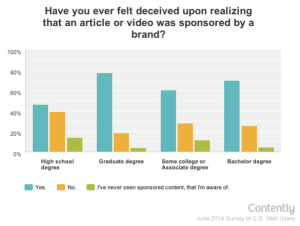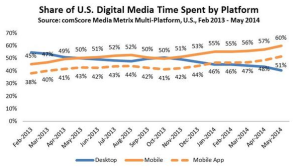Native ads, ad recall levels, mobile apps, print and digital revenue forecasts, and more are among the topics covered in this month’s installment of TFP’s Media Metrics roundup.
We compile excerpts from some of the key stories covering issues affecting the publishing and media industries each month to help you keep up with current media industry trends and prepare for changes that are just around the corner. Here are our top picks.
 Study: Sponsored Content Has a Trust Problem (Contently)
Study: Sponsored Content Has a Trust Problem (Contently)
- While 48% of 542 U.S. Internet users aged 18-65 said they believe “Sponsored Content” means that an advertiser paid for the article to be created and had influence on the article’s content, more than half (52%) thought it meant something different.
- Two-thirds of readers have felt deceived upon realizing that an article or video was sponsored by a brand.
- 54% of readers don’t trust sponsored content.
- 59% of readers believe a news site loses credibility if it runs articles sponsored by a brand.
Study: Magazine Tablet Edition Ads Get Same Recall as Those in Print (Advertising Age)
- GfK MRI Starch Advertising Research unit found ads in tablet versions of magazines had an average 52% level of recall, the same as for ads in the print editions.
- The most-recalled tablet magazine ads were recalled by over 80% of readers, in line with the most-recalled print ads.
- That also suggests, however, that tablet editions’ interactive capabilities are not yielding tablet-edition ads that are much more memorable than plain print ads.
 Major Mobile Milestones in May: Apps Now Drive Half of All Time Spent on Digital (comScore)
Major Mobile Milestones in May: Apps Now Drive Half of All Time Spent on Digital (comScore)
- Mobile platforms–smartphones and tablets–combined to account for 60% of total digital media time spent, up from 50% a year ago.
- Perhaps more impressively, mobile apps accounted for more than half of all digital media time spent in May, coming in at 51%.
- Total mobile engagement on social has grown 55% in the past year.
- Social is the home of the No. 1 mobile property, Facebook, which accounts for 24% of all mobile time spent. The primary Facebook app accounts for 18% on its own.
As Mobile Ad Revenue Continues to Soar, Newspapers Still Struggle to Catch the Wave (Poynter)
- According to eMarketer’s midyear ad forecast, ad spending will grow more than 5% in 2014 for the first time in 10 years. And the mobile ad boom shows no sign of plateauing, with 83% growth over 2013 expected.
- Digital giants like Facebook and Google continue to dominate the category (together more than 50%), while newspapers and magazines struggle to offer competitive ad buys on their mobile products.
- The research firm sees mobile advertising revenues passing the total ad revenues for newspapers this year and more than tripling them by 2018.
U.S. Publishing Industry Earned $27.01B in Net Revenues Last Year (Galleycat)
- The U.S. book publishing industry generated $27.01 billion in net revenue in 2013, selling 2.59 billion units, according to a report from the Association of American Publishers and BISG.
- This was down slightly from $27.12 billion in net revenue and 2.62 billion units in 2012.
- BookStats Volume 4 revealed that the trade sector, which includes consumer fiction and nonfiction, generated $14.63 billion in net revenue and represented 2.32 billion units sold.
- This was down slightly from 2012, in which the category brought in $14.98 billion in net revenue and 2.36 units were sold.
Key Insights From the PwC Global Entertainment and Media Outlook 2014-2018 (FIPP)
- In 2015, the magazine publishing industry will reverse years of decline to record 0.2% year-on-year growth as overall digital gains outweigh falling print revenue.
- In 2018, total magazine revenue will reach $98.1 billion, up from $97.1 billion in 2013.
- While digital consumer magazine circulation revenue will see the fastest growth, global digital consumer magazine circulation revenue will rise at a 31.2% CAGR, reaching $5.7 billion in 2018.
- Global digital consumer magazine advertising revenue will be $12.4 billion in 2018, rising at a 17.6% CAGR. This compares to a decline of -3.9% CAGR for consumer magazine print advertising revenue.
- Growth in digital circulation will not be enough to compensate for print declines and global consumer magazine circulation revenue will fall by a -0.7% CAGR to 2018.
Magazine Audiences Growing (MediaPost)
- A group of 200 leading U.S. magazines tracked by GfK MRI saw their combined print audience increase 1.1% from 1.17 billion in spring 2013 to just under 1.19 billion in spring 2014. (These figures include some print readers who also read digital editions.)
- When all readers of digital editions were included, these magazines saw total audience rise even more—with a 1.7% increase from 1.19 billion in spring 2013 to just under 1.21 billion in spring 2014.
- The number of “digital only” readers jumped 37% from 16.9 million in spring 2013 to 23.2 million in spring 2014.
Only About 10% of Online Readers Pay for News (Poynter)
- Despite news organizations’ efforts to offer readers more ways to pay for digital news, only about 10% of online users worldwide are actually paying, according to a new report from Reuters Institute for the Study of Journalism at the University of Oxford.
- Of those who do pay for news, a higher proportion are paying for online subscriptions. The figure rose from 43% to 59%, “compared with a one-off payment like a day pass or app download.”
- Sixty-one percent of people who pay for their news around the world are male, more than half have a master’s or bachelor’s degree, and about 42% get their news on a tablet.
New Study Finds Internet Not Responsible for Dying Newspapers (University of Chicago Booth School of Business)
- By comparing the amount of time people actually see an ad, University of Chicago Booth School of Business Professor Matthew Gentzkow finds that the price of attention for similar consumers is actually higher online.
- In 2008, he calculates, newspapers earned $2.78 per hour of attention in print, and $3.79 per hour of attention online. By 2012, the price of attention in print had fallen to $1.57, while the price for attention online had increased to $4.24.
- Gentzkow also points out that the popularity of newspapers had already significantly diminished between 1980 and 1995, well before the Internet age, and has dropped at roughly the same rate ever since.
Why Are Journalists Publishing Before Checking Facts? (10,000 Words)
- A new survey from Dutch company ING found that 45% of international journalists “publish as soon as possible and correct later,” while only 20% always do their due diligence before publishing.
- Additionally, the 2014 Study Impact of Social Media on News reported that one-third of journalists don’t consider social media posts a reliable source of information. Still, 50% said the majority of their news tips and facts come from social.
- But journalists don’t seem to mind questions of accuracy too much, since 60% said they feel less restricted by journalistic standards in their social media reporting.
Americans’ Confidence in News Media Remains Low (Gallup)
- Confidence in newspapers has declined by more than half since its 1979 peak of 51%, while TV news has seen confidence ebb from its high of 46% in 1993, the first year that Gallup asked this question. Gallup’s only previous measure of Internet news was in 1999, when confidence was 21%, little different from today.
- Slightly less than one-fifth of self-identified conservatives (15%) say they have a great deal or quite a lot of confidence in newspapers, tied with the 10-year low. Liberals are far more likely than conservatives—or than the adult population in general—to be confident in newspapers (34%). Nearly a quarter of moderates (24%), meanwhile, have confidence in newspapers.
- More than a fifth of liberals (22%) and moderates (22%) say they have a great deal or quite a lot of confidence in news from the Internet, while slightly fewer conservatives (17%) say this.
Book Revenues Are Up—but Without Ebooks, They’d Be Plummeting (Vox)
- According to data released by the Association of American Publishers (AAP), ebook sales continued a steady rise in 2013.
- Total book sales in 2013 was almost $15 billion, according to the AAP. That’s a 14% increase since 2008.
- Ebooks accounted for $3 billion. If we took ebooks out, print book sales would, in fact, be down almost 8% since 2008.
Tablet Shipments to Overtake PCs in 2015 (MediaPost)
- Research firm Gartner projects that almost 321 million tablets will be shipped next year compared to 261.7 million traditional PCs (desktop and notebook computers).
- Adding in “premium” ultramobiles, which include high-end laptop/tablet hybrids like Windows 8 devices and Gartner classifies as PCs, would bring the total PC market in 2015 to nearly 317 million.
- This year, 256 million tablets, including the iPad and Android-based devices, will ship, versus 308 million PCs, including 296,000 traditional units.
- Despite years of shrinking sales, 2014 is shaping up as a relative bright spot for PCs. After declining 9.5% in 2013, the global market is on pace to contract only 2.9% this year, thanks in part to Microsoft ending support for Windows XP.
Media Metrics is a monthly feature from Technology for Publishing, aimed at keeping you armed with the latest industry data. If you’d like to share something you’ve read, drop us a note. And keep up with the latest industry news coverage by signing up for our This Week in Publishing emails or our monthly Publishing Trends newsletter.
Posted by: Margot Knorr Mancini


